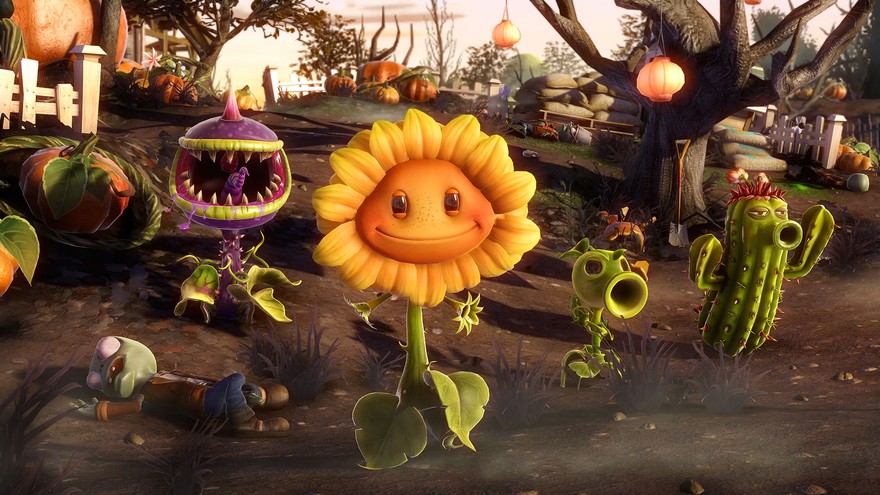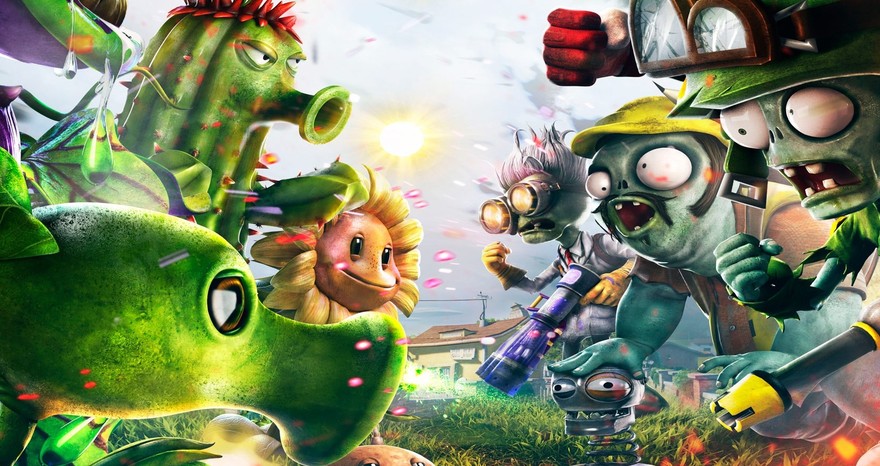Plants vs. Zombies: Garden Warfare, PopCap’s upcoming third-person shooter that’s violent in a cuddly way, started as what senior producer Brian Lindley described as “horrifically complex.”
Garden Warfare began life as a first-person shooter, a genre that people typically associate with being hardcore—lots of bloody headshots, tons of swearing over headset mics. The immense popularity of the Plants vs. Zombies tower-defense games gave PopCap the opportunity to change that image into something friendlier. It wanted to make a skill-based multiplayer shooter on par with Call of Duty or Team Fortress 2, but when playtesters struggled to figure out which buttons did what, the team knew it had a problem.
“We stripped everything down to basically a primary weapon and three or four abilities for every character, and we didn’t really look back after that,” said Lindley. “So we’ve got with our core mechanics a lot of the things that you’d find in those [mainstream] shooters, but we kind of wrapped and remixed them in ways that I believe makes them a bit more approachable—and makes the characters themselves really simple to play.”

Players unlock abilities one by one after completing a few simple challenges—there’s no XP system to learn, so they shouldn’t feel overwhelmed. Those objectives get more difficult over time, but they contribute to a player’s overall rank, which is a simple sum of his or her levels between the eight playable characters on both the zombie and plant side.
And coins, which PvZ veterans will remember earning during showdowns on house lawns, are easy rewards and incentives that can be redeemed for sticker packs with fun prizes, like customization items. PopCap designed the virtual store like a collectible-card game on purpose. Mobile players will find the nature of those click-and-get upgrades hard to resist.
Players will have to play first to get them, of course, and shooters can be intimidating. Lindley says the Sunflower is a good starter character that helps immerse newcomers in an online experience without throwing them to the wolves like in many fiercely competitive shooters.
“It’s not really about running and gunning and being a super-accurate twitch gamer,” he said. “It’s more about working with your team and following them around and healing them. And from that starting point, you can see the overall mechanics and how the other characters work. That pulls you more gradually into the experience instead of feeling like, ‘Oh, I gotta go shoot something right away, and I gotta try to survive with all these highly experienced players.’”
PopCap knew the characters would be the heart of Garden Warfare. The charm, the narrative, the universe—all of it was already there from past games. “I think it’s a type of game where, yeah, it’s kind of cartoony and it’s violent in its own kind of silly way, but it’s not a modern-military or futuristic, more mature theme, and I think that’s something that parents and kids will gravitate to,” said Lindley. “Parents especially, I’m sure, would love to have a less gritty and realistic option to have their kids play.”
All of which may sound like sacrilege to the traditional shooter fan, but as those games have scaled up in complexity they risk suffering the fate of fighting games, becoming the sanctum of only a chosen few. Garden Warfare could reclaim the genre.
To help broaden its usability, PopCap added local split-screen multiplayer and Boss Mode, which uses either Kinect or a SmartGlass device. Both features are exclusive to the Xbox One and, contrary to the newer technology needed to play them, conjure memories of old days spent with friends and family huddled around a tiny television, crowding the couch.
“A father and son could be sitting down on the couch playing co-op together as plants, trying to survive against endless waves of crazy zombies. Meanwhile, mom or brother could be on a SmartGlass device playing Boss Mode, helping to support them from above, just using the touch-screen device.”

Garden Warfare has the DNA of a legitimate shooter, said Lindley, and it’s built with Frostbite 3, the same engine powering games like Battlefield 4. But the world and characters that people have already fallen in love with should secure a broader audience—parents and children, friends and family.
“It’s probably a bit daft to suggest that we’ll get hundreds of millions of downloads like PvZ 2 or the original PvZ have had on mobile,” he said, “but in terms of just an active, engaged player base that is healthy and helps support the game through its life cycle, I think definitely we can get on something that approaches what the other PvZ games have achieved.”
“Does that mean your 80-year-old grandma’s going to want to play?” said Lindley. “Possibly not, but you could put a SmartGlass device in her hands, and she could sit there and play Boss Mode, collecting sun and deploying resources, very much like playing the original PvZ. I think there are opportunities for a huge variety of age groups to get involved just given the features we have, but the core of the experience is something that your core gamer is really going to be able to sink their teeth into.”
What’s most exciting about the game, though, is the way it could help do away with those delineations to begin with.
